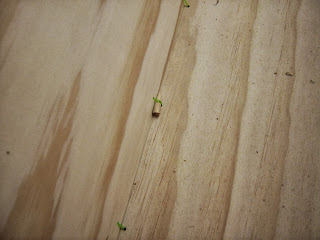Bulkhead
The one end that's now sewn together is a big floppy item, remarkably unlike anything you'd put to sea in. It has to be stiffened into a torsion box with a decked-in end and a wossname - a thingy - all the nautical terms escape me - a bulkhead, thank you. I need to seal each end into a huge hollow box using a deck and a bulkhead, not only to stiffen the structure but also both to contain air as flotation and to remove swampable volume. How much sea will come in is not yet known, but when Graeme came poddling over from next door to see how I was getting on and I started to ruminate on where to step the mast, he recalled that he hoped I was going to start with the Optimist rig.
'There's a lot of wind out there. You won't want much sail. Not while you're learning.'
I intend to try a shunting rig eventually but I tend to pay attention to Graeme. He's lived in his house since 1948 and sailed at the wharf at the end of the road for most of those years. When the sun comes out after a cool night, the onshore winds are - um - exciting. Even in the Optimist they're exciting. You come back to shore and a little old lady walking her dog along the seafront stops and says
'I bet that was a good sail!'
and you hazard a private guess that she was once Graeme's Outdoor Ed mistress.
I hied me along to the builders' merchant with an offcut from the side planks and examined their racks full of plywood until Jasper came out to attend to me.
"Hi Jasper, I'm after some sheets like this."
"Uh, let's have a look - that's 4mm SS UT and it should be in this rack, aaaaand - looks like we haven't got any. It's Woody, not Jasper. I do look like Jasper. Only more handsome."
"Oh, sorry, Woody."
"Woolly. Not Woody."
"Oh, sorry Woolly. - Why d'they call you Woolly?"
"Short for William."
Damn. Willie. I can never quite get the local accent. - One of my neighbours always calls me Ruptured. -
Anyway, as Jasp - as Wullie pointed out, there was no 4mm SS UT. And none in Nelson, Takaka, or Blenheim, according to their computer. No demand. At $76 dollars a sheet I can imagine the explanation, but it means that I'm either going to have to use 4mm CD UT or order a palletful, which means sixty sheets. SS means both sides have a lovely smooth intact veneer. CD means only one side is smooth and the other side is oh, so-so. UT means untreated, were anyone to ask. I gather it takes glue better. Though how they glue it up into ply becomes an unanswered question.
Accordingly I have the choice of whether to put the so-so side on the outside where at least I can keep an eye on it for delamination, or use 7mm ply instead. Since every naval architect tells me that boats always get heavier as you build them, I'm taking a chance on the rubbish grade 4mm, and reinforcing all the edges.
The next task is to glue laths around the bulkheads' edges, and this includes gluing a reinforced hole in the middle. Slightly dodgy 4mm ply isn't going to like inspection hatches, but I don't want a sealed bulkhead full of damp and foetid air where rust and moths break in and steal. - Specifically, rot since the wood is untreated. - So it needs a whacking great big opening that can be removed after each excursion. Mr. Grill had the cunning idea of fitting the top of a bucket as a waterproof hatch.
CRT's buckets are $28 each with a lid but we have lots of old paint buckets wh. are free, and I like the idea of free. Unf. those paint buckets go brittle in the sunshine, so I'll have a problem when the inevitable happens. A bridge to be crossed anon.
In order to make the hole a nice circle I made a compasses extension for the jigsaw, and drilled a central hole as a pivot, and proudly started cutting, and it didn't work. The jigsaw cut a spiral, not a circle. When I watched, the reciprocating saw-blade began to flex at an angle, the angle increasing as the curve proceeded. I took the extension off and cut it much more accurately by hand.
It keeps surprising me that sticking a motor onto a tool is a way of simultaneously making it more saleable and less controllable. I can't think why I should be surprised, since it's a fairly consistent result. We are sold the idea that attaching 400W and a long black cable with an electric plug at the end of it will now obviate the need for skill.
Labels: Bulkhead, paint tub hatch, Proa build, stitch wedges, wandering jigsaw



























